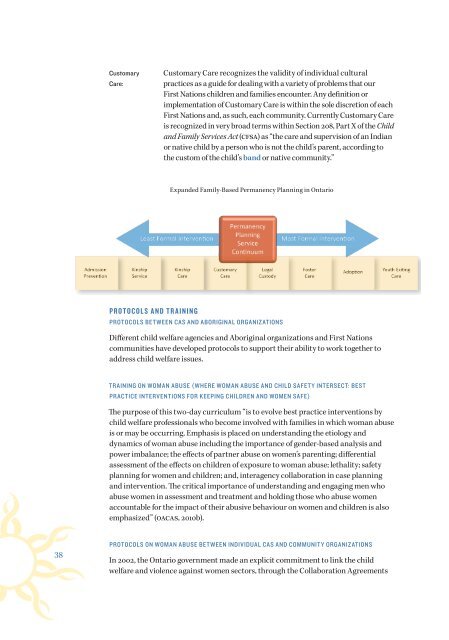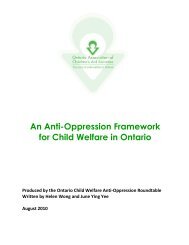English - Ontario Association of Children's Aid Societies
English - Ontario Association of Children's Aid Societies
English - Ontario Association of Children's Aid Societies
You also want an ePaper? Increase the reach of your titles
YUMPU automatically turns print PDFs into web optimized ePapers that Google loves.
Customary<br />
Care:<br />
Customary Care recognizes the validity <strong>of</strong> individual cultural<br />
practices as a guide for dealing with a variety <strong>of</strong> problems that our<br />
First Nations children and families encounter. Any definition or<br />
implementation <strong>of</strong> Customary Care is within the sole discretion <strong>of</strong> each<br />
First Nations and, as such, each community. Currently Customary Care<br />
is recognized in very broad terms within Section 208, Part X <strong>of</strong> the Child<br />
and Family Services Act (CFSA) as “the care and supervision <strong>of</strong> an Indian<br />
or native child by a person who is not the child’s parent, according to<br />
the custom <strong>of</strong> the child’s band or native community.”<br />
Expanded Family-Based Permanency Planning in <strong>Ontario</strong><br />
PROTOCOLS AND TRAINING<br />
PROTOCOLS BETWEEN CAS AND ABORIGINAL ORGANIZATIONS<br />
Different child welfare agencies and Aboriginal organizations and First Nations<br />
communities have developed protocols to support their ability to work together to<br />
address child welfare issues.<br />
TRAINING ON WOMAN ABUSE (WHERE WOMAN ABUSE AND CHILD SAFETY INTERSECT: BEST<br />
PRACTICE INTERVENTIONS FOR KEEPING CHILDREN AND WOMEN SAFE)<br />
The purpose <strong>of</strong> this two-day curriculum “is to evolve best practice interventions by<br />
child welfare pr<strong>of</strong>essionals who become involved with families in which woman abuse<br />
is or may be occurring. Emphasis is placed on understanding the etiology and<br />
dynamics <strong>of</strong> woman abuse including the importance <strong>of</strong> gender-based analysis and<br />
power imbalance; the effects <strong>of</strong> partner abuse on women’s parenting; differential<br />
assessment <strong>of</strong> the effects on children <strong>of</strong> exposure to woman abuse; lethality; safety<br />
planning for women and children; and, interagency collaboration in case planning<br />
and intervention. The critical importance <strong>of</strong> understanding and engaging men who<br />
abuse women in assessment and treatment and holding those who abuse women<br />
accountable for the impact <strong>of</strong> their abusive behaviour on women and children is also<br />
emphasized” (OACAS, 2010b).<br />
38<br />
PROTOCOLS ON WOMAN ABUSE BETWEEN INDIVIDUAL CAS AND COMMUNITY ORGANIZATIONS<br />
In 2002, the <strong>Ontario</strong> government made an explicit commitment to link the child<br />
welfare and violence against women sectors, through the Collaboration Agreements

















